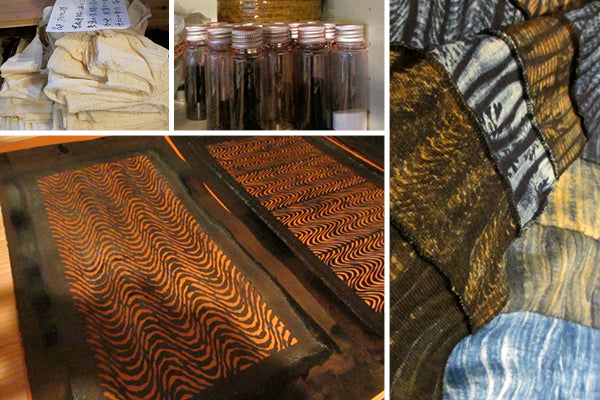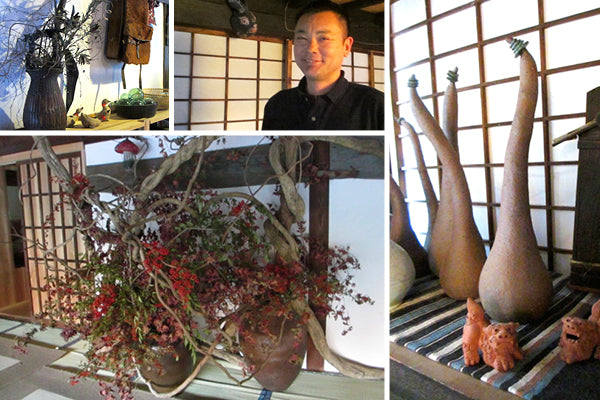By Patricia Belyea
FUJINO JP Leaving early yesterday morning, Michael and I travelled by subway and two trains to the mountain town of Fujino. I had emailed ahead and invited myself to the home of Bryan Whitehead, a Canadian expat and indigo guru.
Byan met us at the Fujino railroad station and took us out to lunch at a hillside Korean restaurant. Over a relaxing meal in a thoughtfully designed yet thoroughly funky restaurant, we began to share our stories.
Careening along winding roads, we next stopped at a weekend market. The enclave of room-sized wooden boxes housed craftspeople’s shops and their wares. In one, a woodworker whittled down hardwoods using a finger plane to make beautiful pairs of chopsticks.
Eventually we arrived at Bryan’s 160-year old silk farming house. Two sweet dogs, rescued from the Fukushima disaster, greeted us warmly. Bryan’s friend Hiro made us all cafe au laits and we settled in to learn more about Bryan’s endeavors.
Over his twenty years in Japan, Bryan has accomplished many things. Yes, he dyes with traditionally fermented indigo but he also grows the indigo plants, prepares the natural dye, and saves seeds to start his crops the following year.

Bryan grows silk worms and the mulberry leaves that feed these ravenous creatures. He harvests the cocoons, extracts the threads and then spins, dyes and weaves the silk.
In a nearby studio, Bryan has refurbished vintage knitting machines. Recently he’s been knitting tubes (essentially socks without heels) from paper fiber that he then dyes and sews together into arty scarves.
Hiro, a contemporary Japanese flower arrangement artist, is Brazillian by birth and Japanese by blood. His compositions of woodland gleanings and flowers contribute intrigue throughout the huge house.
Hiro also makes clay forms that seem to take on a life of their own. In his room, Hiro showed us his new jewelry collection that combines pottery, metal, silk threads and more into assymmetric and inspired necklaces.
Creative energy pulses through Bryan’s home. It emanates from his non-stop curiosity and interest in continually trying out new things. (Other activities I remember him mentioning: growing tea, dyeing with persimmon and madder, putting on art shows in Lichtenstein and making kimonos.)
Many people reach out to Bryan, wanting to experience his world. Two years ago Bryan renovated his upper floors to add bedrooms for ten students and began offering Japanese Textile Workshops. The response has been overwhelming with participants coming from around the world.
Late in the afternoon, Bryan enthusiastically invited Michael and I to stay for dinner. For the next hour and a half, Bryan and I cruised through iPhoto files on his oversized Mac monitor. I loved seeing images of the silkworm lifecycle—something I’d like to see in person.
With his kitchen pulled apart for a remodel, five of us piled into to Bryan’s mini Jeep-like vehicle to drive to Shu—a contemporary Japanese restaurant. Joining us was Anneke, a PhD student from the Netherlands. For the next two hours we ate fabulous food and talked about everything under the Rising Sun.
Michael and I were dropped off at the Fujino station three minutes before an express train whisked us back to Tokyo.
Our ten-hour visit with Bryan was possible due to his openness and generosity of spirit. Also, it was a wintery day-off between seasons—seasons of indigo dyeing, silkworm cultivation and workshops.
Although I didn't see indigo in action or hear silkworms munching mulberry leaves at a fantastic rate or try my hand at weaving or shibori dyeing, I got to spend a whole day with Bryan. What an amazing treat.



















